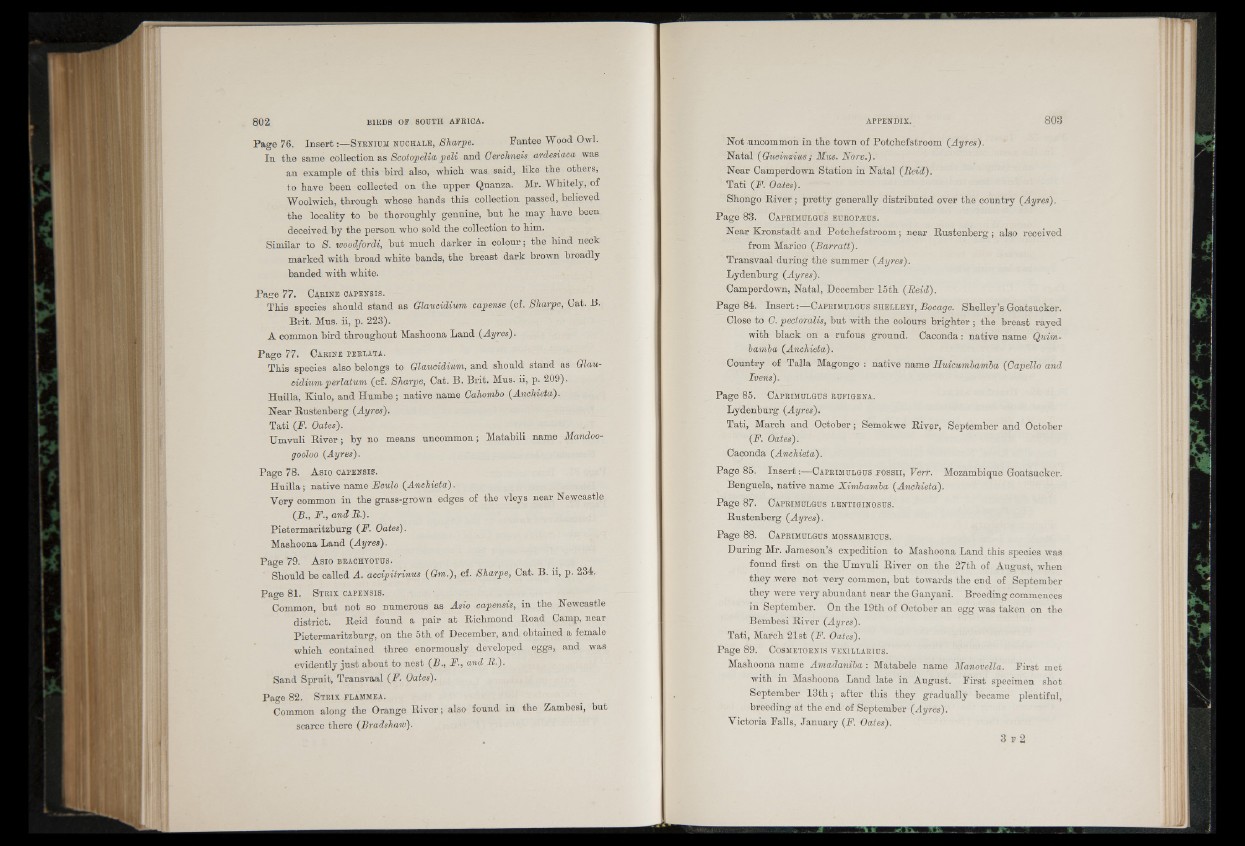
Page 76. Insert:—S y rn ium nuchale, Sharpe. Fantee Wood Owl.
In the same collection as Scotopelia peli and Gerchneis ardesiaca was
an example of this bird also, which was. said, like the others,
to have been collected on the upper Quanza. Mr. Whitely, of
Woolwich, through whose hands this collection passed, believed
the locality to be thoroughly genuine, but he may have been
deceived by the person who sold the collection to him.
Similar to S. woodfordi, but much darker in colour; the hind neck
marked with broad white bands, the breast dark brown broadly
banded with white.
Page 77. Carine capensis.
This species should stand as Glaucidiwm capense (cf. Sharpe, Cat. B.
Brit. Mus. ii, p. 223).
A common bird throughout Mashoona Land (Ayres).
Page 77. Carine perlata.
This species also belongs to Glaucidiwm, and should stand as Glau-
cidiurn perlatum (cf. Sharpe, Cat. B. Brit. Mus. ii, p. 209).
Huilla, Kiulo, and Humbe ; native name Cahombo {Anchieta).
Near Rustenberg (Ayres).
Tati (F. Oates).
Umvuli River; by no means uncommon; Matabili name Mandoo-
godoo (Ayres).
Page 78. Asio capensis.
Huilla; native name Eculo (Anchieta).
Very common in the grass-grown edges of the vleys near Newcastle
(.B., F., and B.).
Pietermaritzburg (F. Oates).
Mashoona Land (Ayres).
Page 79. Asio brachyotus.
Should be called A. accipitrinus (Gm.), cf. Sharpe, Cat. B. ii, p. 234.
Page 81. S trix capensis.
Common, but not so numerous as Asio capensis, in the Newcastle
district. Reid found a pair at Richmond Road Camp, near
Pietermaritzburg, on the 5th of December, and obtained a female
which contained three enormously developed eggs, and was
evidently just about to nest (P., F., and B.).
Sand Spruit, Transvaal (F. Oates).
Page 82. S t r i x flammea.
Common along the Orange River; also found in the Zambesi, but
scarce there (Bradshaw).
Not uncommon in the town of Potchefstroom (Ayres).
Natal (Gueimzius; Mus. Norv.).
Near Camperdown Station in Natal (Beid).
Tati (F. Oates).
Shongo River; pretty generally distributed over the country (Ayres).
Page 83. C aprimulgus europ^ us.
Near Kronstadt and Potchefstroom; near Rustenberg; also received
from Marico (Barratt).
Transvaal during the summer (Ayres).
Lydenburg (Ayres).
Camperdown, Natal, December 15th (Beid).
Page 84. Insert:—Caprimulgus she l l eyi, Bocage. Shelley’s Goatsucker.
Close to G. pectoralis, but with the colours brighter; the breast rayed
with black on a rufous ground. Caconda: native name Quim-
bamba (Anchieta).
Country of Talla Magongo : native name Huicumbamba (Gapello and
Ivens).
Page 85. C aprimulgus rufigena.
Lydenburg (Ayres).
Tati, March and October; Semokwe River, September and October
(F. Oates).
Caconda (Anchieta).
Page 85. Insert:—Caprimulgus fo s s ii, Verr. Mozambique Goatsucker.
Benguela, native name Ximbamba (Anchieta).
Page 87. Caprimulgus lentiginosus.
Rustenberg (Ayres).
Page 88. Caprimulgus mossambicus.
During Mr. Jameson’s expedition to Mashoona Land this species was
found first on the Umvuli River on the 27th of August, when
they were not very common, but towards the end of September
they were very abundant near the Ganyani. Breeding commences
in September. On the 19th of October an egg was taken on the
Bembesi River (Ayres).
Tati, Mafch 21st (F. Oates).
Page 89. C osmetornis vexillarius.
Mashoona name Amadaniba : Matabele name Manovella. First met
with in Mashoona Land late in August. First specimen shot
September 13th; after this they gradually became plentiful,
breeding at the end of September (Ayres).
Victoria Falls, January (F. Oates).
3 p 2